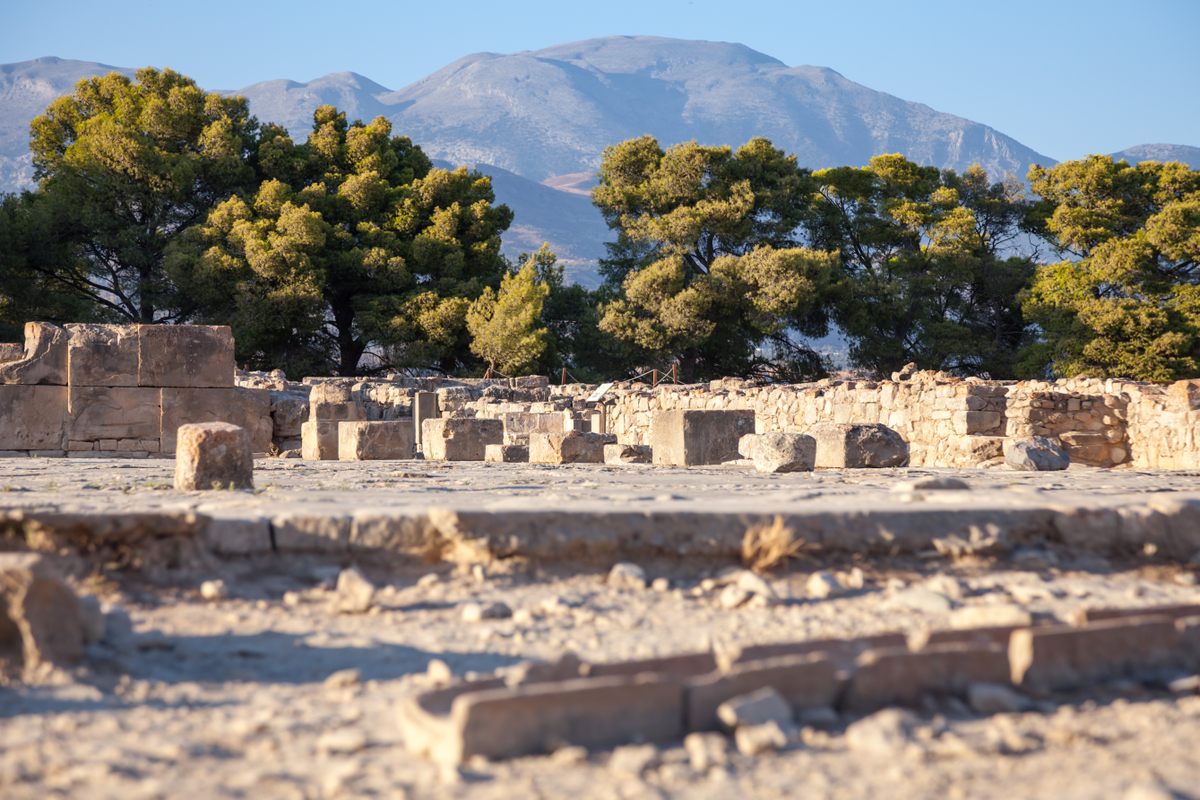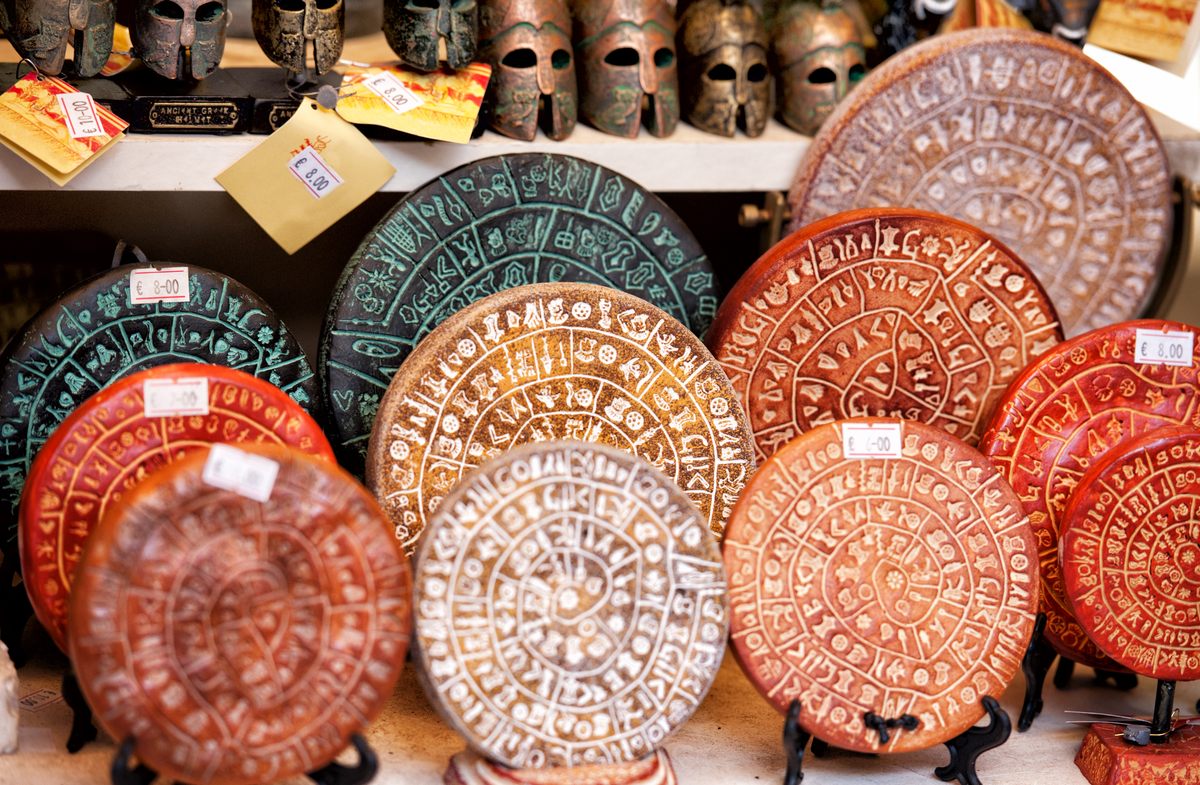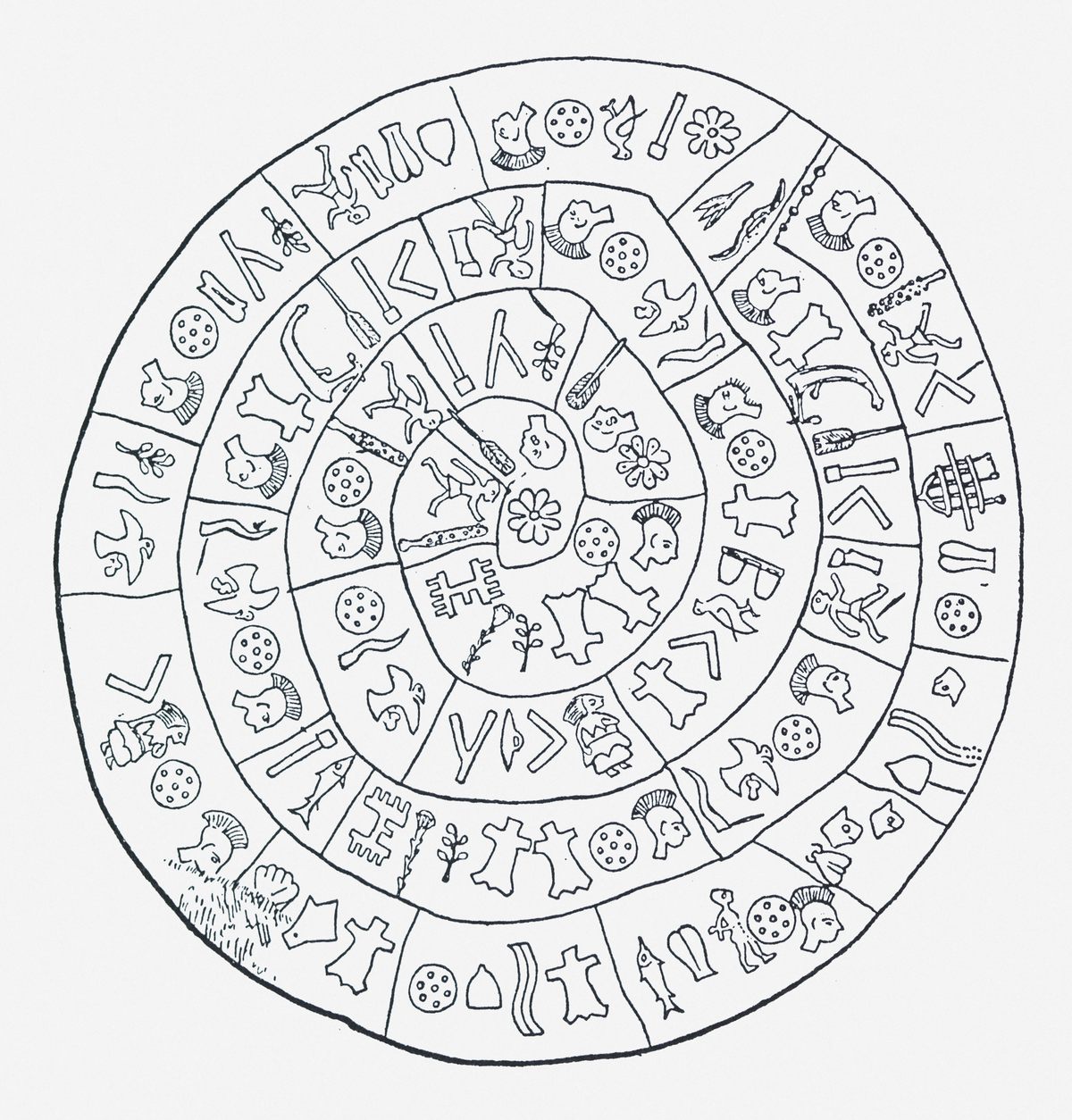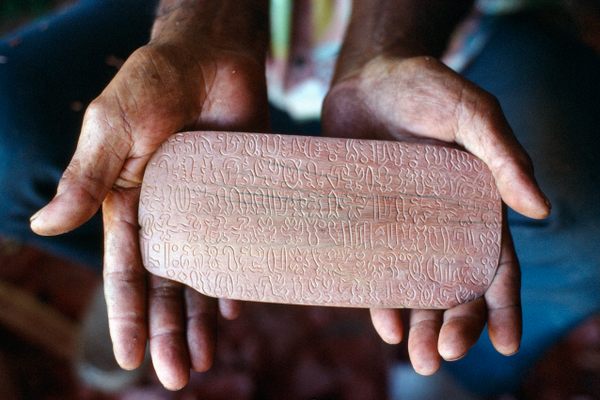Exploring the Enduring Mystery of Crete’s Phaistos Disc
A scholar of Aegean civilization considers the inscrutable meaning of the artifact—and its irresistible appeal.
Excerpted from The Greatest Invention: A History of the World in Nine Mysterious Scripts by Silvia Ferrara. Published by Farrar, Straus and Giroux. Copyright © 2019 by Giangiacomo Feltrinelli Editore s.r.l. Translation copyright © 2022 by Todd Portnowitz. All rights reserved.
On the Old Continent, on Crete, hidden among the ancient Aegean scripts from 4,000 years ago, is another script, perhaps an isolate, perhaps not, but certainly the most mysterious of all. And like all the most hidden and impenetrable mysteries, it’s right there before our eyes, hiding in plain sight. Along with Cretan Hieroglyphic and Linear A, there’s a script that’s infamous among experts and wildly famous to everyone else. In Greece, it’s a much abused and inflated emblem, like the Eiffel Tower in Paris or the gondola in Venice. Its image is everywhere—stamped, printed, painted, drawn, copied, prey to what is often the most gimmicky marketing and consumption—part of an idea of “Greekness” that has nothing to do with actual Greeks.
The Phaistos Disc. Phaistos is one of the great Minoan palaces, and its disc was retrieved there in the early 20th century by an Italian archaeologist, Luigi Pernier. No archives were found in the palace—nothing like the grand archives excavated at Knossos, in the island’s north, brimming with tablets of Linear A and Linear B; nor like the archives of Linear A tablets found at the Hagia Triada site, a settlement just to the south of, and contiguous with, Phaistos. At Phaistos there seemed to be no trace of writing at all. Though how could that be possible, Pernier asked himself: How could such an imposing and monumental palace, with its regal and grandiose staircases, contain only a few scattered inscriptions?
It was 1908, and the final dig was set to take place. Their funds for exploring the palace were running out. A tough moment for Pernier. Not least because, according to others around him, he was consumed with envy for his rival archaeologists and their sensational discoveries. Pernier needed his big break.

And that’s exactly what he got. His discovery of the Phaistos Disc was heralded by all, rivals included, as the find of the year. Phaistos quickly gained wide notoriety. The disc astonished everyone. It was like nothing seen before.
How is it that such a small object—16 inches of humble clay—became the island’s icon, the gondola of Crete? What makes it so magnetic? The answer is simple: It’s there in the crossword you do on Sunday morning, in mystery novels, in all the true-crime series on TV, in the stubborn and unrequited love that keeps you glued to your phone, waiting for a message. The answer lies in the shadows, in life’s blind spots, in the rush of engaging our analytical capacities, in all our predictions and expectations of what’s to come. The answer is the most alluring of all mysteries: the desire to grasp what we don’t know, to get there before anyone else. To intuit, to probe. To decipher.
We’re easy prey for the unknown. It binds us to the future. And the more something is shrouded in obscurity, the darker the corner, the more desperately we want to turn our flashlights on it.
Even the tiniest object, like the Phaistos Disc, is all it takes. We’re hooked. A spiral of illegible, incomprehensible signs lures us into hypnosis. And the enigma lies not only in the script, but in the circumstances surrounding its discovery, its history, the doubts about its authenticity. All that revolves around the Phaistos Disc speaks of bewilderment, of trap doors and unsolved puzzles. It feels almost like a game of Clue, with a dose of Scrabble.
What’s the first thing that happens when you have a little luck, like our Luigi Pernier? The rumormongers pounce, of course. It’s no more than a fraud, I tell you! A disc forged from the resentment of a bitter and envious archaeologist, desperate for glory. No chance that it’s authentic. Pernier is swindling us all. The disc is a fake.

Might the rumormongers have a point? Is it really a fake? Good question. Let’s case the situation. First, we have an Italian (and therefore suspicious) archaeologist, caught up in a competitive environment; then we have a cash-strapped excavation campaign, down to its last drop of funding. In such a bind, one forged discovery could turn things around. And anyone who operates in the world of academia knows that it’s much easier to poison the university well with wickedness and envy than it is to keep the waters clear with collaboration and dialogue.
But enough with the rumors. Let’s look at the facts. What’s really going on here? The disc is most certainly unusual, with its perfectly stamped symbols, its smooth and well-shaped rim. It looks like it could have been made yesterday. Even if it isn’t, it sure does seem like a fake. And there are those who still believe it is, even among colleagues who are experts in the field. The archaeological context in which it was found, however, is solid and trustworthy. And so is its dating, attributable to the same period in which Cretan Hieroglyphic and Linear A coexisted on the island, even if in different locations. The disc was discovered near a tablet engraved in a very archaic form of Linear A. Taking all of this into account, and with the skeptics’ blessing, we must conclude that Pernier never forged anything, that the disc is “good,” as the slang goes. It’s time we bury this fabulous tale of deceptions and hoaxes, this rumor, under all the layers of useless academic diatribes.
Enough with the tall tales. Let’s pose some legitimate questions: What purpose could such a disc have served? And what’s written on it?

The Phaistos Disc is not an administrative text. Its spiraling symbols recall those of another disc, from a later period, this one made of lead and inscribed in a language that to this day remains all but incomprehensible, Etruscan. Pernier cites the Magliano Disc right off the bat in his excavation report, as if to say, “full disclosure: I didn’t copy anything.” The two objects are very similar, though it’s merely a strange coincidence. Etruria and Crete have no historical connections, and the dates are simply too far apart.
What if it’s a race game, then, a kind of Chutes and Ladders? Among the thousands of interpretations, this, too, has been suggested, believe it or not. The Egyptians played a game called mehen, on circular tablets, where the track follows the shape of a coiled snake. Mehen, in fact, means “coiled one,” the snake-god, and the track along its body marks the passage from life to death. Our modern-day Chutes and Ladders is of course less solemn, and rather less macabre. Might the Phaistos Disc be a relic of Cretan amusement, the work of some scribe bored with compiling lists of wool and sheep? I highly doubt it.
And it may be that the disc is a less isolated case than we think. Spirals were not unknown to the Minoans: we find them on rings, for example, with Linear A circling around the setting; or on your basic conical cups, the inside painted with a spiral of Linear A. No easy task, painting signs around the inside of such a deep goblet—and not easy to read, either. Though nothing is less legible than this disc. Its inscription—since, at the end of the day, it’s an inscription that we’re talking about here—is an inscrutable puzzle, an impossible challenge.
Here again, we’re prey to the unknown, and this time we have no choice but to concede the victory. There are certain things we must admit that we don’t know, that we can’t know, that we’ll never know. So, shall we throw in the towel?
A spiraling series of symbols, on both sides, nearly all recognizable: men of various sorts and in various poses, a woman, a fish, a flower, a jar, axes, a bee, a dove, and many other figures, some of which are repeated. The Minoan world, all right there. And yet these symbols bear only a vague resemblance to Cretan hieroglyphs. Where do they come from? And what are they doing on this disc?
Nested in the mystery of this object are two other mysteries. The first is that it was baked purposefully at a high temperature to ensure its longevity. An unusual occurrence, given that the Linear A tablets and clay documents with Cretan hieroglyphs were conserved only because they were “burned,” cooked in the fires that destroyed first the Minoan then the Mycenaean palaces. Baking the clay renders the tablets almost indestructible. It is therefore merely a happy coincidence that these objects were salvaged and arrived to us in near perfect condition. Let’s call it the serendipity of the Aegean epigraphers.
The second mystery is that the signs are not engraved in the clay. They’re stamped. The first printing—centuries before Gutenberg and his movable type, which wouldn’t come until the European Renaissance of the 15th century. This disc is ahead of the game, with its characters all in a row, arranged in a circle. A precursor with no historical continuity, because the Cretan molds were used to stamp no other object. The Phaistos Disc is a unicum.

Two hundred and forty-two signs, in sequences of clearly and intentionally divided words, which tells us that this is in all likelihood a true written language. Though if that’s the case, are we looking here at a syllabic script, like Cretan Hieroglyphic and Linear A, or a logographic script, where each sign indicates a morpheme (which is to say, a word)? The first possibility stands on better ground, but there aren’t enough total signs to validate the hypothesis. And that’s precisely the curse of a unicum. There’s no way to prove or disprove anything. Not only is it an isolate, it’s a black swan: rare, one of a kind, even, impossible to ignore, and cursed.
Cursed because it bars us from applying the scientific method—meaning that no one, not ever, will be able to decipher it. With subtle English irony, the philologist John Chadwick—who helped Michael Ventris decipher Linear B—wrote the following about the Phaistos Disc: “If King Minos himself were to reveal to someone in a dream the true interpretation, it would be quite impossible for him to convince anyone else that his was the one and only possible solution.” Period. End of story. We’re back to start in our game of Chutes and Ladders, with a dead-end track where no one wins. As they say in Rome, alla fine del tunnel ci sono solo i fari del camion: the only light at the end of the tunnel is the light of an oncoming truck.


























Follow us on Twitter to get the latest on the world's hidden wonders.
Like us on Facebook to get the latest on the world's hidden wonders.
Follow us on Twitter Like us on Facebook